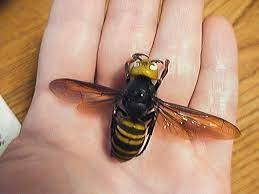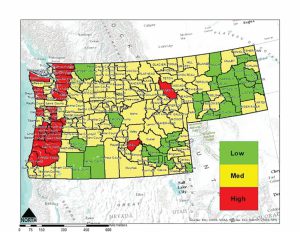Erik Norderud & Robert Peterson PhD
Summary
The recent introduction of the Asian giant hornet, Vespa mandarinia Smith, in the United States in late 2019 has raised concerns about its establishment in the Pacific Northwest and its potential negative effects on honey bees, Apis spp., and their pollination services in the region. Therefore, we conducted a risk assessment of the establishment of V. mandarinia in Washington, Oregon, Montana, and Idaho on a county-by-county basis. Our risk assessment relied on the biological requirements and ecological relationships of V. mandarinia in the environments of the Pacific Northwest. Our risk characterization was based on climate and habitat suitability estimates for V. mandarinia queens to overwinter and colonize nests, density and distribution of apiaries, and locations of major human-mediated introduction pathways that may increase establishment of the hornet in the counties. Our results suggest that 32 counties in the region could be at low risk, 120 at medium risk, and 23 at high risk of establishment. Many of the western counties in the region were estimated to be at the highest risk of establishment mainly because of their suitable climate for queens to overwinter, dense forest biomass for nest colonization, and proximity to major port and freight hubs in the region. By design, our risk assessment most likely overestimates the risk of establishment, but considering its negative effects, these counties should be prioritized in ongoing monitoring and eradication efforts of V. mandarinia.
 What is risk assessment?
What is risk assessment?
Risk assessments are a formalized process that are undertaken to objectively evaluate risk and frame the potential impacts of a particular stressor or hazard, with the ultimate goal of conferring the degree of risk that a stress or hazard imposes on health and human safety, economic sectors and industry, or ecosystems. The risk assessment process varies, but typically follows three steps. The first step is the initial problem formulation, which sets the scope, steps, and methods of the risk assessment by defining the stressor and its effects. The second step is the analysis phase, which seeks to gather and apply relevant data and information in order to ultimately aid in outlining the ‘effects’ and ‘exposure’ characterizing a particular stressor and its impacts. The final phase of a risk assessment is the risk characterization, or more simply put, the product of effect and exposure used to characterize risk of the stressor on its environment.
Problem Formulation
Invasive species risk assessments follow the same step-based framework of any other risk assessment, and focus on the negative effects that the invasive species in question tenders on its environments and ecosystems it inhabits. In the case of our risk assessment, these were the risks that the establishment of the Asian giant hornet presents to the ecosystems of the Pacific Northwest United States. Below we describe, analyze, and characterize those risks of establishment of the Asian giant hornet in the Pacific Northwest.
 Stressor Description
Stressor Description
The Asian giant hornet (Vespa mandarinia) is the largest known species of the hornet in the world, clocking in at approximately two inches in length. As its name would suggest, the insect is native to Asia and is found throughout China, Japan, South Korea, and even parts of Russia. The Asian giant hornet primarily feeds on various insects as a protein source such as beetles, spiders, and social wasps, but also utilizes sap sources from soft fruits. However, the Asian giant hornet is probably most well known for being an expert predator of honey bees in which mass attack by the hornets can result in the decimation of entire colonies of honey bees. This behavior has caused issues worldwide and is a direct threat to the critical pollination services that honey bees provide.
The life cycle of the Asian giant hornet typically spans a few months, and begins with a solitary mated queen initiating nest foundation in the late spring following an overwintering period. Nests are typically founded in ‘green’ environments such as forests, parks, and other herbaceous areas. The colony begins to take shape in the early Summer and workers begin to emerge. Mating season begins in the early Fall before the activity of the colony gradually decreases and ceases in early Winter when the newly mated queens must find a new site to overwinter in preparation for next season.
Effects and Exposure Assessment
The effects assessment in our risk assessment relied on mated queens surviving their overwintering period and establishing a new colony the following season, and the negative effects that these colonies incur upon the ecosystem during their lifecycle. The primary negative effects were the loss of pollination services provided by European honey bees and the potential resulting economic risk to agriculture sectors in the form of crop production and apiculture.
Drawing from the stressor description and effects assessment, our exposure assessment aimed to analyze the ecosystems and environments of the Pacific Northwest and compare them to the ecological requirements of the hornet. In order to accomplish this, we primarily analyzed suitable climate for the insect to survive its overwintering period, suitable habitat to foster nest foundation, apiary densities in the region to serve as a food source for the hornet, and major port and freight hubs which may serve as additional introduction pathways for the hornet on a county-by-county basis across Washington, Oregon, Montana, and Idaho.
Risk Characterization
To estimate the risk the Asian giant hornet poses to each county of the four Pacific Northwest states, we used a risk rating and scoring system to rank the risk based on the above the risk factors mentioned above. Each risk factor was scored on a basis of one to four, one being the lowest risk score and four being the highest risk score, for a total possible overall risk score of 12 across the four risk factors. Counties across the four states which received an overall risk score one to four were ranked as ‘low’ risk, counties with a score of five to eight were deemed ‘medium’ risk, and counties with a score of nine to 12 were designated as ‘high’ risk. The overall risk map for Asian giant hornet establishment across the four states is shown below.
Erik Norderud and Robert Peterson are from the Department of Land Resources & Environmental Sciences, Montana State University, Bozeman, MT 59717









